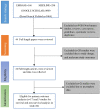Serum Activity of Liver Enzymes Is Associated With Higher Mortality in COVID-19: A Systematic Review and Meta-Analysis
- PMID: 32793616
- PMCID: PMC7387424
- DOI: 10.3389/fmed.2020.00431
Serum Activity of Liver Enzymes Is Associated With Higher Mortality in COVID-19: A Systematic Review and Meta-Analysis
Abstract
Background: Abnormal liver chemistries are common findings in patients with COVID-19. It is unclear whether abnormal liver chemistries can predict the severity of COVID-19. Therefore, we compared the serum liver chemistries such as hepatic transaminases, total bilirubin, albumin, and prothrombin time to evaluate whether they can predict severity and mortality in COVID-19. Methods: An electronic search was performed on PubMed/Medline, EMBASE, and Google Scholar for studies comparing liver chemistries in severe and mild COVID-19. The literature search was performed using keywords "COVID-19," "Liver," Aspartate Aminotransferase (AST)," and "Alanine Aminotransferase (ALT)," "AST," and "ALT," in various combinations of "AND/OR" from December 1, 2019, till May 8, 2020. The pooled weighted mean difference (WMD) and 95% confidence interval (CI) were calculated for each component of liver chemistries. Results: Twenty-two studies were eligible, with 3,256 patients (54.57% males). Seventeen studies compared liver chemistries for severe vs. mild COVID-19, whereas five studies compared liver chemistries in survival vs. non-survival groups. The pooled WMD of AST and ALT in severe vs. mild COVID-19 were 12.23 (95% CI; 8.07, 16.39; p < 0.01) and 8.07 (95% CI 2.55, 11.91; p < 0.01), respectively. The pooled WMD for AST in survivors vs. non-survivors analysis was 8.82 (n = 789; 95% CI; 2.27, 15.37; p < 0.01) and that of ALT was 4.70 (n = 340; 95% CI 0.04,9.35; p = 0.05). Conclusion: Our meta-analysis shows that deranged liver chemistries may indicate severe COVID-19 and could also predict mortality. Larger studies are needed to evaluate the relationship between derangement in liver chemistries and mortality in COVID-19.
Keywords: COVID-19; LFT; SARS-CoV-2; coronavirus; liver chemistries; liver tests.
Copyright © 2020 Boregowda, Aloysius, Perisetti, Gajendran, Bansal and Goyal.
Figures




References
-
- OMS OMdls. WHO Coronavirus Disease (COVID-19) Dashboard. World Health Organization (2020). Available online at: https://covid19.who.int/
-
- Prevention CfDCa. CDC COVID Data Tracker. Centers for Disease Control and Prevention (2020). p. 6–7. Available online at: https://www.cdc.gov/covid-data-tracker/#cases
Publication types
LinkOut - more resources
Full Text Sources
Miscellaneous

